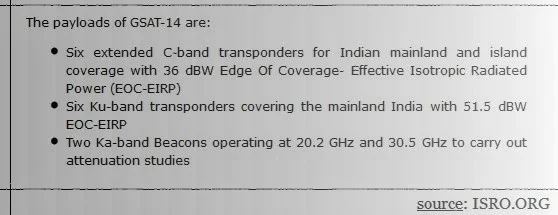On 5th January, 2014, Indian Space Research
Organisation or ISRO launched the GSLV-D5 with the indigenous cryogenic engine.
The Indian rocket engine was launched from Satish Dhawan Space Centre, SriHarikota
spaceport, Andhra Pradesh, to establish the communication satellite GSAT-14 in
Earth’s orbit.
GLSV-D5 at a glance
The GSLV-D5 or Geostationary Launch Vehicle is a launch
rocket with three different stages including the Cryogenic engine at its third
stage, burning liquid oxygen-oxidised liquid hydrogen. The success of Geostationary
Launch Vehicle – D5 with Indian-built cryogenic engine has played a major role
by cutting the expenses of a satellite launch by half. As told by ISRO’s
chairman K.Radhakrishnan to IANS, the country used to pay more than 500 crore
Indian Rupee, that is, $90 million dollars per launch of a 3.5 tonne satellite excluding
the price of satellite, while Indian GSLV costs 220 crore Indian Rupees (INR)
only. ISRO as its next step expects to build their next Launch vehicle of GSLV
series in the coming time which can send a load of 3 to 4 tonnes. Currently,
ISRO can only send satellites the weigh around 2 tonnes or less.
The success of cryogenic engine has been seen only after
several failed attempts by ISRO. Earlier, two such rockets of ISRO, GSLV D3 and
GSLV F06 carrying loads of 2220 kg and 2130 kg respectively had failed to
launch in year 2010. GSLV-D5 is the only successful launch vehicle after between
years 2007 and 2014.
What is GSAT-14?
GSAT-14 is an Indian geostationary communication satellite constructed
by Indian Space Research Organisation (ISRO). Before this, India has launched 22
other geostationary communication satellites to the planet’s orbit. As updated
by ISRO, the 23rd satellite of India, GSAT-14 will have the
following two objectives:
- To augment the In-orbit capacity of Extended C and Ku-band transponders.
- To provide a platform for new experiments.
The cuboid-shaped GSAT-14 has two solar arrays, each having
two panels which will be able to generate 2600 watts power for the
satellite. The satellite is provided
light-weight Lithium-Ion batteries to power the system during the eclipse
period. The GSAT-14 has been built to provide services for about 12 years of
time.
Payloads of GSLV-14
Experiments/Technologies
GSAT-14 has been introduced with the following new
technologies by ISRO:
- Fiber Optic Gyro (FOG)
A Fiber Optic Gyro or FOG is a gyroscope that is capable of
providing an exact and accurate rotational rate information and higher
resolutions than that of a ring laser gyroscope. Fiber Optic Gyroscope is also
used in inertial navigation systems of various missiles and under water
navigation.
- Active Pixel Sun Sensor
Active Pixel Sensor or APS is an image sensor that consists
of a MEMS or Micro Electro-Mechanical system, photo-detectors and active
amplifiers. It forms the images as the Sun illuminates the pixel sensors. It
has an array of pixel sensors contained by an integrated circuitry.
- Ka band beacon propagation studies
To study the attenuation and sky noise caused by rain and
water vapour to the signals and related issues with Ka band beacon propagation.
It is noted that Ka band has the frequencies ranging from 26.5 to 40 GigaHertz.
- Thermal control coating experiments
The same experiments/technologies were included in the GSAT-4
satellite program in year 2010, but the mission had met failure.








+facility.jpg)


Comments
Post a Comment